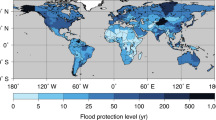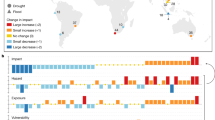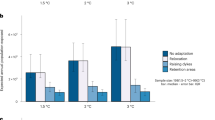Abstract
Flood risk management in the USA is largely embedded in the National Flood Insurance Program (NFIP). Climate change and increasing exposure in flood plains pose a challenge to flood risk managers and make it vital to reduce risk in the future. The proposed reforms are steering the NFIP to risk-based premiums, but it is uncertain if the reforms will result in unaffordability and incentivize risk-reduction investments or how the NFIP is affected by large-scale adaptation efforts. Using an agent-based model approach for current and future scenarios, we demonstrate that risk-based premiums will yield a positive societal benefit (US$10 billion) because they will incentivize household risk-reduction investments. Moreover, our results show that proactive investment in large-scale adaptation measures complements a transition to risk-based premiums to yield a higher overall societal benefit (US$26 billion). We suggest that transitioning the NFIP to risk-based premiums can only be secured by additional investments in large-scale flood protection infrastructure.
This is a preview of subscription content, access via your institution
Access options
Access Nature and 54 other Nature Portfolio journals
Get Nature+, our best-value online-access subscription
$29.99 / 30 days
cancel any time
Subscribe to this journal
Receive 12 print issues and online access
$209.00 per year
only $17.42 per issue
Buy this article
- Purchase on Springer Link
- Instant access to full article PDF
Prices may be subject to local taxes which are calculated during checkout

Similar content being viewed by others
Data availability
Land-cover data were obtained from GlobeLand30,42. Inundation data were obtained from the GLOFRIS cascade model33. Vulnerability curves were obtained from HAZUS-MH model44. Maximum damage values are available at ref. 43. NFIP insurance data are available at ref. 55. Income data were obtained from the US Census Bureau59. Protection standard database was obtained from FLOPROS50. NFIP Redacted Claims dataset is available from FEMA73. FEMA and the Federal Government cannot vouch for the data or analyses derived from these data after the data have been retrieved from the Agency’s website(s) and/or Data.gov. Socio-economic data were obtained from the International Institute for Applied Systems Analysis74. The generated data that support the finding of this study are available in figshare with the identifiers: https://doi.org/10.6084/m9.figshare.17049416.v1. There are no restrictions on data availability.
Code availability
The code for DYNAMO is available in Zenodo with the identifiers: https://doi.org/10.5281/zenodo.7025225. There are no restrictions on code availability.
References
Merz, B. et al. Causes, impacts and patterns of disastrous river floods. Nat. Rev. Earth Environ. 2, 592–609 (2021).
Mills, E. Insurance in a climate of change. Science 309, 1040–1044 (2005).
Ward, P. J. et al. A global framework for future costs and benefits of river-flood protection in urban areas. Nat. Clim. Change 7, 642–646 (2017).
Winsemius, H. C. et al. Global drivers of future river flood risk. Nat. Clim. Change 6, 381–385 (2016).
Tiggeloven, T. et al. Global-scale benefit–cost analysis of coastal flood adaptation to different flood risk drivers using structural measures. Nat. Hazards Earth Syst. Sci. 20, 1025–1044 (2020).
Horn, D. P. & Webel, B. W. Introduction to the National Food Insurance Program (NFIP, 2019).
Michel-Kerjan, E. O. & Kunreuther, H. Redesigning flood insurance. Science 333, 408–409 (2011).
Risk Rating 2.0 Overview (FEMA, 2019).
Mechler, R. & Schinko, T. Identifying the policy space for climate loss and damage. Science 354, 290–292 (2016).
Di Baldassarre, G., Kooy, M., Kemerink, J. S. & Brandimarte, L. Towards understanding the dynamic behaviour of floodplains as human-water systems. Hydrol. Earth Syst. Sci. 17, 3235–3244 (2013).
Di Baldassarre, G. et al. Debates—perspectives on socio-hydrology: capturing feedbacks between physical and social processes. Water Resour. Res. 51, 4770–4781 (2015).
Di Baldassarre, G. et al. Socio-hydrology: conceptualising human-flood interactions. Hydrol. Earth Syst. Sci. 17, 3295–3303 (2013).
Grames, J., Prskawetz, A., Grass, D., Viglione, A. & Blöschl, G. Modeling the interaction between flooding events and economic growth. Ecol. Econ. 129, 193–209 (2016).
Dawson, R. J., Peppe, R. & Wang, M. An agent-based model for risk-based flood incident management. Nat. Hazards 59, 167–189 (2011).
Filatova, T. Empirical agent-based land market: integrating adaptive economic behavior in urban land-use models. Comput. Environ. Urban Syst. 54, 397–413 (2015).
Hassani-Mahmooei, B. & Parris, B. W. Climate change and internal migration patterns in Bangladesh: an agent-based model. Environ. Dev. Econ. 17, 763–780 (2012).
Tonn, G. L. & Guikema, S. D. An agent-based model of evolving community flood risk. Risk Anal. 38, 1258–1278 (2018).
Tonn, G. L., Guikema, S. & Zaitchik, B. Simulating behavioral influences on community flood risk under future climate scenarios. Risk Anal. 40, 884–898 (2019).
Han, Y. & Peng, Z. R. The integration of local government, residents, and insurance in coastal adaptation: an agent-based modeling approach. Comput. Environ. Urban Syst. 76, 69–79 (2019).
Haer, T., Botzen, W. J. W. & Aerts, J. C. J. H. Advancing disaster policies by integrating dynamic adaptive behaviour in risk assessments using an agent-based modelling approach. Environ. Res. Lett. 14, 044022 (2019).
Aerts, J. C. J. H. et al. Integrating human behaviour dynamics into flood disaster risk assessment. Nat. Clim. Change 8, 193–199 (2018).
Sadiq, A. A., Tyler, J. & Noonan, D. S. A review of community flood risk management studies in the United States. Int. J. Disaster Risk Reduct. 41, 101327 (2019).
Blessing, R., Brody, S. D. & Highfield, W. E. Valuing floodplain protection and avoidance in a coastal watershed. Disasters 43, 906–925 (2019).
de Ruig, L. T. et al. An agent-based model for evaluating reforms of the National Flood Insurance Program: a benchmarked model applied to Jamaica Bay, NYC. Risk Anal. https://doi.org/10.1111/risa.13905 (2022).
Kron, W. Flood risk = hazard • values • vulnerability. Water Int. 30, 58–68 (2005).
de Moel, H., van Vliet, M. & Aerts, J. C. J. H. Evaluating the effect of flood damage-reducing measures: a case study of the unembanked area of Rotterdam, the Netherlands. Reg. Environ Change 14, 895–908 (2014).
Riahi, K. et al. The Shared Socioeconomic Pathways and their energy, land use, and greenhouse gas emissions implications: an overview. Glob. Environ. Change 42, 153–168 (2017).
Samir, K. C. & Lutz, W. The human core of the shared socioeconomic pathways: population scenarios by age, sex and level of education for all countries to 2100. Glob. Environ. Change 42, 181–192 (2017).
Dellink, R., Chateau, J., Lanzi, E. & Magné, B. Long-term economic growth projections in the Shared Socioeconomic Pathways. Glob. Environ. Change 42, 200–214 (2017).
Crespo Cuaresma, J. Income projections for climate change research: a framework based on human capital dynamics. Glob. Environ. Change 42, 226–236 (2017).
Leimbach, M., Kriegler, E., Roming, N. & Schwanitz, J. Future growth patterns of world regions—a GDP scenario approach. Glob. Environ. Change 42, 215–225 (2017).
Jiang, L. & O’Neill, B. C. Global urbanization projections for the Shared Socioeconomic Pathways. Glob. Environ. Change 42, 193–199 (2017).
Ward, P. J. et al. Aqueduct Floods Methodology (WRI, 2020); www.wri.org/publication/aqueduct-floods-methodology
Muis, S., Verlaan, M., Winsemius, H. C., Aerts, J. C. J. H. & Ward, P. J. A global reanalysis of storm surges and extreme sea levels. Nat. Commun. 7, 11969 (2016).
Carrère, L. & Lyard, F. Modeling the barotropic response of the global ocean to atmospheric wind and pressure forcing—comparisons with observations. Geophys. Res. Lett. https://doi.org/10.1029/2002GL016473 (2003).
Dee, D. P. et al. The ERA-Interim reanalysis: configuration and performance of the data assimilation system. Q. J. R. Meteorol. Soc. 137, 553–597 (2011).
Muis, S. et al. A comparison of two global datasets of extreme sea levels and resulting flood exposure. Earths Future 5, 379–392 (2017).
Jevrejeva, S., Grinsted, A. & Moore, J. C. Upper limit for sea level projections by 2100. Environ. Res. Lett. 9, 104008 (2014).
Kooi, H., Bakr, M., de Lange, G., den Haan, E. & Erkens, G. User Guide to SUB-CR a MODFLOW Package for Land Subsidence and Aquifer System Compaction that Includes Creep Deltares internal report 11202275-008 (Deltares, 2018).
Guidance for Flood Risk Analysis and Mapping Combined Coastal and Riverine (FEMA, 2015).
Bates, P. D. et al. Combined modeling of US fluvial, pluvial, and coastal flood hazard under current and future climates. Water Resour. Res. 57, e2020WR028673 (2021).
Jun, C., Ban, Y. & Li, S. Open access to Earth land-cover map. Nature 514, 434 (2014).
Huizinga, J., de Moel, H. & Szewczyk, W. Global Flood Depth–Damage Functions: Methodology and the Database with Guidelines (Publications Office of the European Union, 2017); https://doi.org/10.2760/16510
Multi-Hazard Loss Estimation Methodology, Flood Model, HAZUS, Technical Manual (FEMA, 2013).
de Ruig, L. T., Haer, T., de Moel, H., Botzen, W. J. W. & Aerts, J. C. J. H. A micro-scale cost–benefit analysis of building-level flood risk adaptation measures in Los Angeles. Water Resour. Econ. 32, 100147 (2020).
Aerts, J. C. J. H. & Botzen, W. J. W. Flood-resilient waterfront development in New York City: bridging flood insurance, building codes, and flood zoning. Ann. N. Y. Acad. Sci. 1227, 1–82 (2011).
Homeowner’s Guide to Retrofitting—Six Ways to Protect your Home from Flooding (FEMA, 2014).
Aerts, J. C. J. H., Botzen, W. J. W., de Moel, H. & Bowman, M. Cost estimates for flood resilience and protection strategies in New York City. Ann. N. Y. Acad. Sci. 1294, 1–104 (2013).
de Ruig, L. T. et al. An economic evaluation of adaptation pathways in coastal mega cities: an illustration for Los Angeles. Sci. Total Environ. 678, 647–659 (2019).
Scussolini, P. et al. FLOPROS: an evolving global database of flood protection standards. Nat. Hazards Earth Syst. Sci. 16, 1049–1061 (2016).
Hallegatte, S., Green, C., Nicholls, R. J. & Corfee-Morlot, J. Future flood losses in major coastal cities. Nat. Clim. Change 3, 802–806 (2013).
Nicholls, R. & Cazenave, A. Sea-level rise and its impact on coastal zones. Science 328, 1517–1520 (2010).
Czajkowski, J., Villarini, G., Montgomery, M., Michel-Kerjan, E. O. & Goska, R. Assessing current and future freshwater flood risk from North Atlantic tropical cyclones via insurance claims. Sci. Rep. 7, 41609 (2017).
Technical Documentation of NFIP Actuarial Assumptions and Methods (FEMA, 2013).
The National Flood Insurance Program: Financial Soundness and Affordability (Congressional Budget Office, 2017).
Dixon, L. & Clancy, N. The National Flood Insurance Program’s Market Penetration Rate: Estimates and Policy Implications (RAND Corporation, 2006); https://www.rand.org/pubs/technical_reports/TR300.html
Kousky, C. & Kunreuther, H. Addressing affordability in the National Flood Insurance Program. J. Extreme Events 1, 1450001 (2014).
Hudson, P. A comparison of definitions of affordability for flood risk adaption measures: a case study of current and future risk-based flood insurance premiums in Europe. Mitig. Adapt. Strateg. Glob. Change 23, 1019–1038 (2018).
Income Data per County (US Census Bureau, 2010); https://www2.census.gov/geo/tiger/TIGER_DP/2010ACS/
Von Neumann, J. & Morgenstern, O. Theory of Games and Economic Behavior (Princeton Univ. Press, 1947).
Hudson, P., Botzen, W. J. W. & Aerts, J. C. J. H. Flood insurance arrangements in the European Union for future flood risk under climate and socioeconomic change. Glob. Environ. Change 58, 101966 (2019).
Harrison, G. W., List, J. A. & Towe, C. Naturally occurring preferences and exogenous laboratory experiments: a case study of risk aversion. Econometrica 75, 433–458 (2007).
Bombardini, M. & Trebbi, F. Risk aversion and expected utility theory: an experiment with large and small stakes. J. Eur. Econ. Assoc. 10, 1348–1399 (2012).
Wakker, P. P. in Wakker, P. P. (ed) Prospect Theory for Risk and Ambiguity Ch. 3 (Cambridge Univ. Press, 2008).
Kunreuther, H. Mitigating disaster losses through insurance. J. Risk Uncertain. 12, 171–187 (1996).
Bin, O. & Landry, C. E. Changes in implicit flood risk premiums: empirical evidence from the housing market. J. Environ. Econ. Manag. 65, 361–376 (2013).
Kunreuther, H., Sanderson, W. & Vetschera, R. A behavioral model of the adoption of protective activities. J. Econ. Behav. Organ. 6, 1–15 (1985).
Bubeck, P., Botzen, W. J. W. & Aerts, J. C. J. H. A review of risk perceptions and other factors that influence flood mitigation behavior. Risk Anal. 32, 1481–1495 (2012).
Tol, R. S. J. The social cost of carbon. Annu. Rev. Resour. Econ. 3, 419–443 (2011).
Nicholls, R. J. Coastal flooding and wetland loss in the 21st century: changes under the SRES climate and socio-economic scenarios. Glob. Environ. Change 14, 69–86 (2004).
Aerts, J. C. J. H. A review of cost estimates for flood adaptation. Water 10, 1646 (2018).
Cirillo, P. & Gallegati, M. The empirical validation of an agent-based model. East Econ. J. 38, 525–547 (2012).
OpenFEMA Dataset: FIMA NFIP Redacted Claims (FEMA, accessed 23 June 2020); https://www.fema.gov/openfema-data-page/fima-nfip-redacted-claims
Keywan, R. et al. The Shared Socioeconomic Pathways and their energy, land use, and greenhouse gas emissions implications: an overview. Global Environmental Change 42, 153–168 (2017).
Acknowledgements
We would like to thank M. Montgomery for sharing data and M. Tesselaar for his feedback. This research received funding from the Netherlands Organization for Scientific Research VIDI (45214005 to W.J.W.B.) and VICI (016140067 and 453-13-006 to J.A.) grant programmes and ERC advanced grant (884442 to J.A.).
Author information
Authors and Affiliations
Contributions
The work was conceptualized by L.T.de R., T.H., W.J.W.B. and J.A. The methodology was developed by L.T.de R., T.H. and H.de M. Formal analysis was undertaken by L.T.de R. and T.H. Visualization was by L.T.de R. and H.de M. Supervision and funding acquisition were by J.A. The article was written by L.T.de R., H.de M., S.D.B., W.J.W.B., J.C. and J.C.J.H.A.
Corresponding authors
Ethics declarations
Competing interests
The authors declare no competing interests.
Peer review
Peer review information
Nature Climate Change thanks Dylan Turner, Yu Han, Brett Sanders and Brayton Noll for their contribution to the peer review of this work.
Additional information
Publisher’s note Springer Nature remains neutral with regard to jurisdictional claims in published maps and institutional affiliations.
Extended data
Extended Data Fig. 1 A schematic overview of the primary modelling steps.
A schematic overview of the primary modelling steps, showing the main buildings blocks of the DYNamic climate impact Adaptation Model (DYNAMO): (a) modelling schematic: a flood risk model and an agent-based model, (b) input data: flood maps, exposure data, flood protection data, income, (c) scenarios: socio-economic and climate change scenarios until 2050, (d) policy scenarios: governmental adaptation policies and NFIP market structures, (e) outputs: flood risk (EAD), insurance penetration rates, affordability, disaster risk reduction (DRR), and flood protection standards, (f) validation: damage and premium income. The framework builds upon earlier applications and version of DYNAMO by Haer et al.21 for the EU and de Ruig et al.28 for New York City.
Supplementary information
Supplementary Information
Supplementary Methods, Results, benchmarking, validation and sensitivity analyses, Figs. 1–5 and Tables 1–12.
Rights and permissions
Springer Nature or its licensor holds exclusive rights to this article under a publishing agreement with the author(s) or other rightsholder(s); author self-archiving of the accepted manuscript version of this article is solely governed by the terms of such publishing agreement and applicable law.
About this article
Cite this article
de Ruig, L.T., Haer, T., de Moel, H. et al. How the USA can benefit from risk-based premiums combined with flood protection. Nat. Clim. Chang. 12, 995–998 (2022). https://doi.org/10.1038/s41558-022-01501-7
Received:
Accepted:
Published:
Issue Date:
DOI: https://doi.org/10.1038/s41558-022-01501-7
This article is cited by
-
Flood teleconnections from levees undermine disaster resilience
npj Natural Hazards (2024)
-
Spatially interactive modeling of land change identifies location-specific adaptations most likely to lower future flood risk
Scientific Reports (2023)
-
Unpriced climate risk and the potential consequences of overvaluation in US housing markets
Nature Climate Change (2023)
-
Flood insurance is a driver of population growth in European floodplains
Nature Communications (2023)
-
Integrating climate change induced flood risk into future population projections
Nature Communications (2023)



